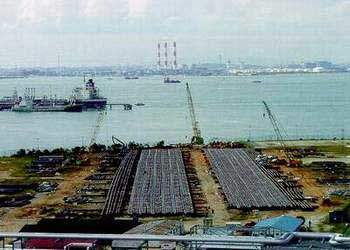
Shell Eastern Petroleum, a unit of Royal Dutch / Shell Group and Petrochemical of Singapore announced in May 2000 that their jointly owned 70,000bpd condensate splitter unit had commenced operations.
The splitter, jointly owned by Shell and PCS and situated at Shell’s 59,000t per day Pulau Bukom refinery, started up on 24 May 2000 and reached full capacity in early June, however, Shell refrained from giving exact production levels. The unit began processing condensate feedstock from Australia into on-specification-grade naphtha, which is being taken by PCS under a term agreement.
The Pulau Bukom project required an investment, which was valued in the region of $100m. Shell and PCS shared the investment costs in the splitter project on a 50-50 basis.
Pulau Bukom pipeline bundle
The lead contractor for the Pulau Bukom project was Kvaerner. Under the terms of the contract the company was required to install a pipeline bundle to convey naphtha and other products from Singapore port to Jurong Island. The bundle stretches 4.5km on the seabed. Kvaerner used a technique known as bottom pull to achieve the task, which would be otherwise hampered by the intense port traffic.
Pioneered by Kvaerner, bottom pull means pulling a pipeline from one shore across the seabed to the next shore. It is particularly suited to exceptionally active marine areas like the port of Singapore, where conventional techniques, such as lay barge and surface tow, would cause too much interference.
The pipeline is used to link the new condensate splitter unit on the island of Pulau Bukom with downstream users on Jurong Island. The submarine pipeline bundle, which carries naphtha to the Petrochemical Corporation of Singapore’s facility on Jurong Island, is over 4.5km in length and 28m deep in some parts.
The project consists of eight pipelines and two fibre-optic cables, giving a combined pipeline length of over 36km. The pipelines are fabricated from 12m pipe lengths and then welded into 250m lengths, known as strings, before being assembled into a bundle of eight with a series of cross-braces.
The double-armoured fibre-optic cables were fed into the bundled sections as they were pulled across the bottom of the marine fairway by a pulling cable. This uses a special linear winch to generate a pull capacity of over 350t. The maximum linear velocity when pulling is about 4m a minute, although this depends on local conditions.
Singapore legislation demands that the bundle be protected by a layer of armour rock to prevent damage from anchors and other dropped or dragged objects. The seamless pipeline was supplied by Sumitomo in Japan. A 100% radiography of all welds and careful handling of the pipelines during installation was ensured, because once covered by the layer of armour rock, any leaks would be very hard to deal with.
Rock armour protection
Anchor model tests were carried out by a research institution in Australia to check the design basis of the rock armour protection. Using scale model tests various anchor sizes are tested to ensure that rock armour performed under a variety of different conditions, for example, anchors being dropped directly onto the rock armour and also being dragged across the rock armour-protected bundle. Tests showed that the design basis for the armour rock is more than adequate to protect the pipeline bundle.
Now in place the pipeline is being closely monitored by a regime that includes online leak detection and regular intelligent pigging. Coupling this with a heavy-duty cathodic protection system, which is good for a design-life of 50 years, ensures lifelong pipeline integrity.
Kvaerner’s main dredging subcontractor was Van Oord ACZ of Holland. The main subcontractor for the fabrication of the pipeline bundle was McConnell Dowell of Australia.
Ethylene glycol plant, Jurong
In a related project started in August 2006 Foster Wheeler announced that its UK subsidiary, Foster Wheeler Energy (FWEL), and its Singapore subsidiary, Foster Wheeler Asia Pacific (FWAPPL), were instructed by Shell Eastern Petroleum (SEPL) to proceed with the initial engineering, procurement and construction management (EPC) for a large-scale ethylene oxide / mono-ethylene glycol (EO / MEG) plant and a significant refinery modification project in Singapore.
FWEL completed the basic design and engineering package (BDEP) for the new EO / MEG plant, which uses Shell’s proprietary Omega technology. Foster Wheeler’s Asia Pacific operations completed the BDEP for the modifications to the Bukom Refinery and project specification for sulphur recovery and high vacuum units.
Foster Wheeler will now carry this work through to the implementation phase. The new 750,000t a year EO / MEG plant, located on Jurong Island, uses feedstock from an ethylene cracker that was built by others on Bukom Island, Singapore.
Both the cracker and the EO/MEG plant are part of the project known as the Shell Eastern Petrochemicals Complex (SEPC), that was officially completed in May 2010. The project included construction and integration of new facilities with Shell’s existing refinery at Bukom to capture the benefits of oil-chemicals integration.
During the final quarter of 2006 SEPL broke ground for its petrochemical complex located at the Pulau Bukom refinery in Pulau Ular, Singapore. The complex, which is known as the Shell Eastern Petrochemical Complex, became operational in May 2010.
Ethylene crackers
At the end of 2005 a joint venture between Japan’s Toyo Engineering and ABB Lummus Global of the US announced that it had been awarded a contract to provide the BDEP for the SEPL ethylene cracker.
The facility operates at a capacity of between 1mtpa and 1.3mtpa. The joint venture partners said that following a final investment decision by SEPL the BDEP contract would roll over into an engineering procurement and construction management phase.
The cracker is based on propriety technology supplied by ABB Lummus Global and was integrated into the existing refinery.


